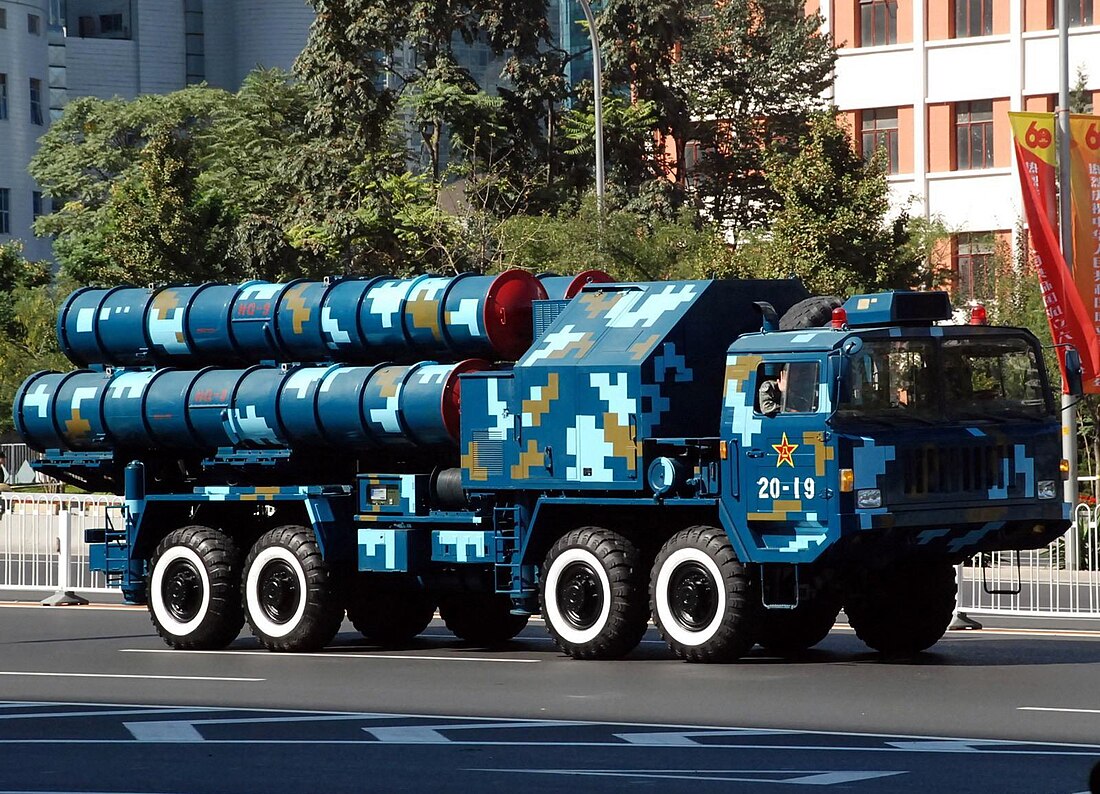HQ-9
Mobile based surface-to-air missile/anti-ballistic missile system From Wikipedia, the free encyclopedia
The HQ-9 (simplified Chinese: 红旗-9; traditional Chinese: 紅旗-9; pinyin: Hóng Qí-9; lit. 'Red Banner-9') is a long-range semi-active radar homing (SARH) surface-to-air missile (SAM) developed by the People's Republic of China.[3][4] The naval variant is the HHQ-9 (simplified Chinese: 海红旗-9; traditional Chinese: 海紅旗-9; pinyin: Hǎi Hóng Qí-9; lit. 'Sea Red Banner-9').[3]
This article has multiple issues. Please help improve it or discuss these issues on the talk page. (Learn how and when to remove these messages)
|
| HQ-9 | |
|---|---|
 An HQ-9 portable launcher during China's 60th anniversary parade in 2009, Beijing | |
| Type | Long-range surface-to-air missile Anti-satellite weapon Anti-ballistic missile |
| Place of origin | China |
| Service history | |
| In service | 2001 – present[1] |
| Used by | See Operators |
| Production history | |
| Manufacturer | China Aerospace Science and Industry Corporation[2] |
| Specifications | |
Operational range | 120 km (HQ-9)[3] 300 km (HQ-9B)[4][5] |
| Flight ceiling | 50 km (HQ-9B)[5] |
| Maximum speed | Mach 4+[3] |
Guidance system | Semi-active radar homing[4] |
Launch platform | HQ-9 ground-launched[6] HHQ-9 surface-launched[3] |
Description
The HQ-9 is a derivative of the Russian S-300.[3][4][7] Justin Bronk of the Royal United Services Institute describes the missile as a "hybrid design based on the Russian SA-20 but with radar, seeker head and C2 elements heavily influenced by American and Israeli technology."[7]
The missile uses track-via-missile (TVM) guidance combining inertial guidance, mid-course uplink, and terminal active radar.[8] The TVM used on earlier missiles may have been developed from a United States MIM-104 Patriot missile purchased from Israel or Germany.[6]
According to a 2001 article from Defence International, the HQ-9 is 6.8 m. long with a mass of nearly two tons. The diameters of the first and second stages are 700 mm and 560 mm, respectively. The warhead mass is 180 kg, and the maximum speed is Mach 4.2. The HQ-9 may use fire-control radars from other Chinese SAM systems.[9]

Variants

- Air defense
- HQ-9

- HHQ-9 — Naval surface-launched variant.[3]
- HQ-9A — Improved version, first tested in 1999 and service entry in 2001.[1]
- HQ-9B — Improved version with a range of up to 260 km and added passive infrared seeker.[4] Reportedly tested in February 2006.[1]
- Ballistic missile defense and anti-satellite
- HQ-19 (NATO reporting name: CH-AB-2)[10] – Anti-ballistic missile variant, reportedly designed to counter medium-range ballistic missiles. It targets ballistic missiles in their midcourse and terminal phases, and it is comparable to the US THAAD.[11] The missile may have "begun preliminary operations" by 2018.[12]
- Export
- FD-2000 – Export variant with a range of 125 km.[6] May be fitted with YLC-20 passive radar against stealthy targets.[13] May use the HT-233 target-acquisition radar,[14] Type 120 low-altitude search radar, and Type 305A AESA search radar.[13]
- FD-2000B – Export variant with a range of 250 km.
- HQ-9P – Custom variant for Pakistan. Range of 125 km for interception against aircraft and around 25 km against cruise missiles.[15][16]
Foreign interest
Summarize
Perspective
Turkey
The HQ-9 was a contender in Turkey's T-LORAMIDS program, and it was reportedly selected as the winner in September 2013.[17] The United States responded by blocking funds to integrate the Chinese system into NATO defenses.[18] However, through 2013 there was no confirmation that the deal had been finalized.[19][20][21] In February 2015, the Grand National Assembly of Turkey was informed by the Ministry of National Defence that the evaluation of bids was complete and that the chosen system would be used by Turkey without integration with NATO; the system was not explicitly named. However, other Turkish officials reported that no winner had been selected.[22] Later in the month, Turkish officials revealed that negotiations were ongoing with multiple bidders; the Chinese bid had not yet satisfied requirements concerning technology transfer.[23] In March 2015, a China Daily article reported that it was "well-known that the Chinese FD-2000 system, a HQ-9 model for export, was chosen for the contract with Turkey in 2013" based on comments made by a CPMIEC representative at the 2015 Langkawi International Maritime and Aerospace Exhibition; the article was misleadingly called "Missile sale to Turkey confirmed."[24] In November 2015, Turkey confirmed it would not purchase the HQ-9, opting for an indigenously developed system instead.[25]
Operating history
China
China has deployed HQ-9s near or in disputed territory. Missiles were deployed in July 2015 to Hotan in Xinjiang, close to Kashmir across the Line of Actual Control,[26] and in February 2016 to Woody Island in the disputed South China Sea.[27][28]
Pakistan
The Pakistan Army operates the HQ-9/P variant.[16] Negotiations for the purchase of the HQ-9 and HQ-16 by Pakistan began in early 2015.[29] The missiles officially entered service on October 14, 2021.[16]
Operators
- People's Liberation Army Air Force - 196 HQ-9, 96 HQ-9B as of 2024[30]
- Royal Moroccan Army - Four batteries of FD-2000B purchased in 2016. The first battery was expected to be delivered in 2020 or 2021.[31]
- Egyptian Air Force - Reports revealed that as of 2025, Egypt has obtained Chinese HQ-9B systems.[35]
See also
- Similar systems
- HQ-22
- Terminal High Altitude Area Defense
- MIM-104 Patriot
- S-300 (missile)
- Medium Extended Air Defense System
- Project Kusha
- Aster
- David's Sling
- Barak 8
- Related lists
References
External links
Wikiwand - on
Seamless Wikipedia browsing. On steroids.
